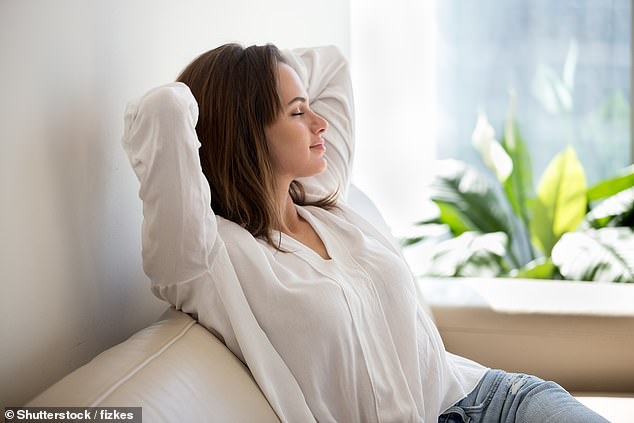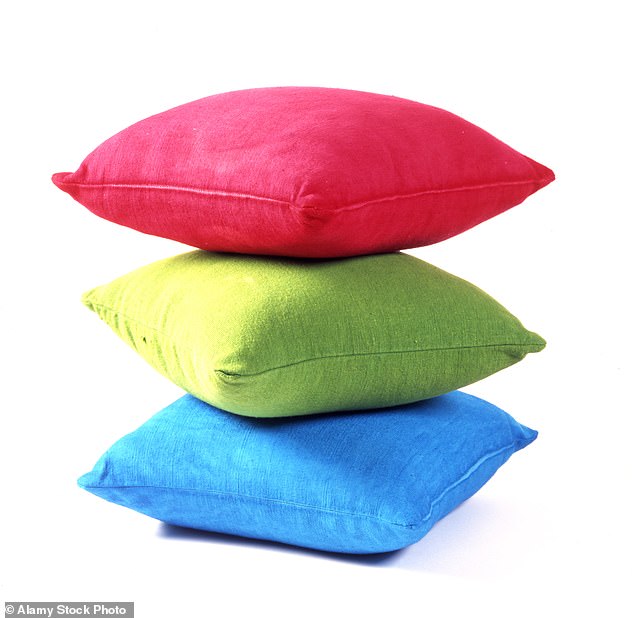Troubled by a sore back lately? Or perhaps you’ve been suffering with neck or knee pain? You’re not alone — research suggests that inactivity and working from home during the pandemic have exacerbated our aches and pains.
Bupa UK research estimates 11 million people in the UK have had an increase in pains such as back or neck aches in the last year.
Fortunately most of the minor day-to-day aches and pains we experience are not caused by an injury or more serious conditions such as a slipped disc or arthritis but are triggered by muscles working incorrectly or being too weak for the pressure we put them under.
Everyday movements such as sitting or standing require a lot of muscles to work — and normally they do this painlessly, explains Jayden Arnold, a physiotherapist at Ten Health and Fitness in London.
‘But if muscles are put under stress for longer than they should be, or if large muscles are weak so the wrong muscles take over, they can’t cope and start to send pain signals to the brain, encouraging us to move.’
Ignoring these signals can lead over time to ‘chronic pain in the area that is taking the load’, he adds.

Bupa UK research estimates 11 million people in the UK have had an increase in pains such as back or neck aches in the last year (stock image)
The good news is that many of the aches and pains produced by what physiotherapists call ‘time under tension’ can be alleviated by ensuring you don’t sit in the same position for more than 45 minutes, and by moving regularly throughout the day so muscles aren’t held in one position for too long.
Experts say there are also some specific techniques and tweaks you can use to help, according to where your aches and pains are — Good Health asked a selection of specialists for their top tips for you to try at home.
But before you start, do a pain audit, says Nell Mead, a physiotherapist based in London. ‘If your pain is severe, interfering with your daily activities, or comes with other symptoms such as tingling or changes in bowel or bladder habits, consult your GP before embarking on home treatment.
‘Pain tweaks should work quite quickly. If you don’t notice any improvement after a week, or pain gets worse, then seek medical advice.’
NECK ACHE
Why aches occur:
The head weighs 5 kg (12 lb) and is balanced on the seven vertebrae of the neck.
‘If you slouch, for instance when you’re slumping forwards over your computer screen, the weight of the head moves and you compensate by poking your chin forward, compressing the space between the neck and the skull,’ explains Nell Mead.
Indeed, a 2018 study by San Francisco State University in the U.S., published in the journal Biofeedback, found the weight of the head increases to the equivalent of hanging a 45 lb weight from your neck if you slump over a computer, and just 30 seconds of ‘neck scrunching’ could trigger pain in 98 per cent of people.
‘The change to the head’s centre of gravity makes the muscles attaching the back of your neck to your upper back work harder — as they get tired, this causes neck pain,’ adds Nell Mead.
As well as neck pain it can lead to headaches due to reduced blood flow and muscle tension.

Have your photo taken. If your neck pain worsens at night, your mattress could be to blame, according to sleep coach Nick Littlehales (stock image)
What you can do:
Check your posture — the researchers involved in the 2018 U.S. study suggested making sure your head is aligned on top of your neck. ‘Get into the right position by imagining a piece of string pulling the crown of your head to the sky,’ advises Nell Mead.Increase your screen font size. You need to be able to see the screen easily while sitting in your chair with your head in this balanced state.
‘If the font is too small, you’ll move your face closer to the screen, creating that tension on the neck muscles,’ says Nell Mead.
Use a computer stand or balance the monitor on a box to ensure your screen is the right height: you should stare directly at the middle of the screen.
Check your bra. Bigger cup sizes need a wider shoulder strap to support the weight of the breast tissue. ‘Thin straps can press into the shoulders, which manifests as pain in the neck,’ says Nell Mead.
The problem, known as costo- clavicular syndrome, occurs when the straps squash the clavicle (your collar bone) closer to the first rib. The resultant pressure on nerves leads to neck and shoulder pain.
‘But you also need a tight back band to spread support — this can become too loose if your bra is older, prompting the head and back to curve forward, leading to neck, shoulder and upper back pain,’ warns Nell Mead.

Breathe more deeply. Changing how people breathed helped reduce chronic neck pain after just three weeks of training, according to a study in the Journal of the Medical Association of Thailand in 2014 (stock image)
Strap size is particularly important during exercise. A 2015 study from the University of Wollongong in Australia, published in the journal Sports Medicine Open, found that women over a D cup needed a sports bra with straps at least 4.5 cm wide to reduce the risk of pain.
Breathe more deeply. Changing how people breathed helped reduce chronic neck pain after just three weeks of training, according to a study in the Journal of the Medical Association of Thailand in 2014.
Nell Mead suggests: ‘Watch in the mirror. Do your shoulders lift up when you inhale? If so, you’re using your neck muscles when you breathe increasing how fast they fatigue. Breathe from your diaphragm instead.
‘Place your hand on your belly and try to draw in air deep into the lungs. Your belly should expand when you inhale and drop back as you exhale and your shoulders should barely move at all.’
Rest your tongue behind your front teeth. Many people unconsciously tense their jaw muscles when concentrating.
‘Jaw clenching and tooth grinding can lead to head and neck pain,’ says Nell Mead. ‘Try to adopt a resting mouth position where your lips are closed, your teeth are slightly parted and your tongue rests behind your top front teeth. This automatically relaxes the muscles of the jaw and neck, reducing tension that leads to pain.’
Have your photo taken. If your neck pain worsens at night, your mattress could be to blame, according to sleep coach Nick Littlehales.
If it’s too firm, your head will drop when you sleep whereas your hips will sink in if it’s too soft, forcing your head and neck upwards. He suggests getting someone to photograph you lying on your side on your mattress to check your spine is straight from base to head. If it’s not, use pillows or mattress toppers to realign your position. You should only need one pillow on a good mattress.
UPPER BACK AND SHOULDER PAIN
Why aches occur:
‘Stress on the neck will also contribute to upper back and shoulder pain, but another common cause is that the forearms are incorrectly positioned,’ explains physiotherapist Jayden Arnold.
‘Using laptops is a common cause, as it means you have to balance your forearms above the keyboard, which the arms aren’t meant to do.
‘To counteract this, you instinctively round your shoulders, leading to shoulder and upper back pain.’
What you can do:
Support your forearms: get a separate keyboard for your laptop ‘and position your chair or keyboard so you can rest your forearms on your desk’, says Jayden Arnold.Clear out your bag: carrying a bag on one shoulder causes you to lift your shoulder to keep it in place. Research at the University of Hertfordshire, published in the Journal of Human Kinetics in 2015, showed this puts pressure on the trapezius muscle, along the upper back.
‘The heavier the bag the more discomfort this will cause — so a bag with one strap should weigh under 3 kg,’ says Jayden Arnold. ‘For anything heavier, use a rucksack with two straps to distribute the weight more equally.’
Roll your shoulders: ‘You can reduce the risk of any kind of pain by moving the muscles that are under tension in the opposite direction regularly,’ says Jayden Arnold.
‘For upper body and shoulders simply rolling your shoulders backwards, once an hour, can make a big difference.’
SORE KNEES? PUT YOUR LEGS UP THE WALL
Why aches occur:
‘In older people, knee pain is rarely the knee’s fault, other than arthritic changes,’ says physiotherapist Nell Mead. ‘If the foot or hip is weak, the knee suffers. So improving these areas is key.’
What you can do:
Roll your feet: ‘If the feet are stiff when they land, the shock transfers to the knees,’ says Nell Mead. ‘Rolling each foot for 30 seconds on a tennis ball can relax the muscles, helping flexibility.’Push off when you walk: ‘Land at the back of the foot and roll through to ease pressure on the knee as you walk,’ says Nell Mead.Clench each buttock: ‘If you can’t clench each buttock separately, it’s a sign of hip weakness which will transfer to the knee,’ says Nell Mead. ‘You need to work the buttocks: try exercises such as bridges [see hips, above].’Lie with your feet up: ‘The muscles of the thigh and lower leg cover the knee, if these are tight they can pull bones closer, causing pain,’ says Nell Mead. ‘To relax these muscles, lie on your back with your feet up the wall. Hold your feet straight for 30 seconds, then point your toes together and out for half a minute each.’ 
Lie with your feet up
Advertisement
LOWER BACK PAIN
Why aches occur:
Sudden, severe back pain might be triggered by a muscle spasm or misplaced disc pushing on the nerve but most day-to-day backache is caused by stiff, tired muscles.
‘The spine can move in six different directions, but most of us sit with it upright for most of the day,’ explains Ruth Smith, a physiotherapist at Complete Pilates in London. ‘This not only tires the supporting muscles but also reduces circulation — when the muscles are deprived of blood and oxygen they also send out pain signals.’
What you can do:
Put a small cushion or rolled-up towel behind the small of your back when you sit: ‘The lower back naturally sits in a gentle curve, but this can get pushed out when you’re sitting — this incorrect posture causes smaller muscles to take on the load, leading them to tire and stiffen painfully — the padding will ensure the back curves,’ says Ruth Smith.Sleep with a pillow under your knees: ‘Inflammation causing pain reduces at night but check your sleep position isn’t straining your back further,’ says Ruth Smith. ‘Checking your mattress [see neck ache] will help, but if you sleep on your back, try placing the extra pillow under your knees.
‘If you sleep on your side, try placing it between your knees. Front sleepers should use a thin pillow under the head and/or try placing another pillow under the abdomen.’
Don’t use your arms to support yourself when you sit or stand.
‘A lot of people with lower back pain do this, but it stops you using all the muscles that should be working, which weakens them and means they’ll tire more easily over time and become more painful,’ says Ruth Smith. ‘Instead, try using your bottom and thigh muscles to stand and to tighten your core.’
Try a pelvic tilt: ‘If you can’t get up and move around regularly, at least do a pelvic tilt in your chair to briefly relieve pressure on the muscles and keep the blood flowing around the lower back,’ says Ruth Smith.
Sit up straight so there’s a curve in your lower spine, then tighten your tummy muscle, drawing your belly button toward your spine.
Gently round your lower back out as if you were flattening it toward the back of the chair, hold for three to ten seconds, then release. Repeat ten times, three times a day.
A study published in the Journal of Women’s Health Care in 2016 found this move helped reduce back pain in new mothers in as little as four weeks.
PAINFUL HIPS
Why aches occur:
‘There’s a lot that works within the hip including bones, muscles, tendons and some hefty nerves,’ says Laura Stocks, a regional physiotherapy lead for Nuffield Health. ‘If any part of this sensitive ecosystem becomes disrupted it can cause us pain.
‘Things that can interrupt the normal function of the hip include stiff, weak or tight muscles and inflammation around the joint linked to arthritis.’
What you can do:
If the pain is worse when sitting, sit with your hips slightly elevated: ‘This opens up the hip joint and stops the muscles tightening,’ says Ruth Smith — you can buy wedge-shaped cushions that help you do this.
Laura Stocks also advises to try not to ‘tuck’ your feet around the legs of the chair — ‘it causes hip rotation and can overstretch the rotator muscles at the back of the hip — if you do it repeatedly they can get sore’.
Press your heels into the floor: ‘When you are sitting, regularly press your heels down into the floor and hold for five seconds,’ says Laura Stocks. ‘This makes the muscles at the back of the hip fire, keeping them stronger. If these are strong it helps prevent smaller, weaker muscles taking over support, which quickly leads to pain.’Take proper strides: ‘Tight weak hips can encourage you to take shorter strides, making the problem worse,’ says Laura Stocks. ‘A longer stride promotes hip strength, stability and control. If you find it hard, try some backwards walking to strengthen the muscles.’Stand up from your chair to take phone calls: ‘Hips do not like to be static and often become weak due to inactivity which increases their risk of becoming painful,’ says Laura Stocks. ‘This is a simple way to strengthen them.’ 
If the pain is worse when sitting, sit with your hips slightly elevated: ‘This opens up the hip joint and stops the muscles tightening,’ says Ruth Smith — you can buy wedge-shaped cushions that help you do this (stock image)
Source link : https://www.dailymail.co.uk/health/article-10058525/Tiny-tweaks-banish-aches-pains.html











